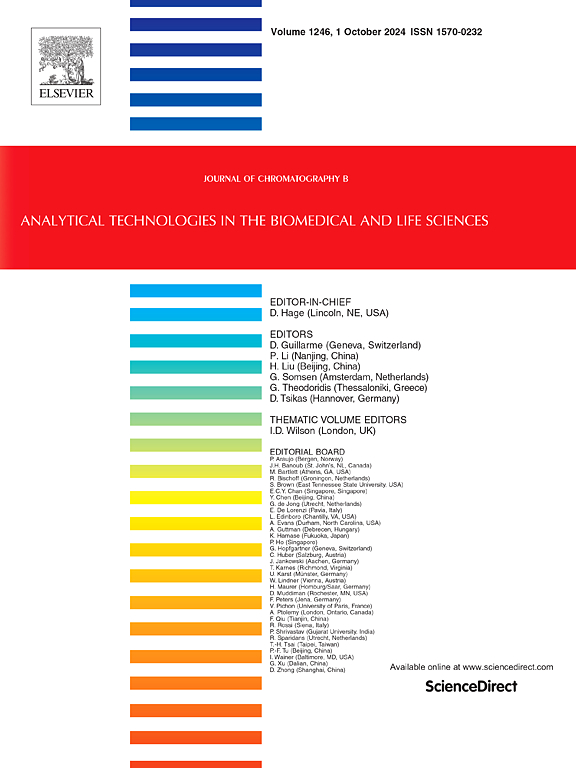A novel LC-MS/MS assay for low concentrations of creatinine in sweat and saliva to validate biosensors for continuous monitoring of renal function
IF 2.8
3区 医学
Q2 BIOCHEMICAL RESEARCH METHODS
引用次数: 0
Abstract
Monitoring of kidney function traditionally relies on plasma creatinine concentrations, necessitating invasive blood draws. Non-invasively obtainable biofluids, such as sweat and saliva, present a patient-friendly alternative with potential for continuous monitoring. This study focusses on developing and validating a novel Liquid Chromatography- tandem Mass Spectrometry (LC-MS/MS) assay as a reference test for measuring low creatinine concentrations in sweat and saliva. We explore the correlation between these biofluids and plasma creatinine concentrations during haemodialysis to support future biosensor applications. Creatinine concentrations were measured in sweat, saliva, and plasma obtained from forty patients undergoing haemodialysis. A novel LC-MS/MS assay was developed to quantify low creatinine concentrations in sweat and saliva. Correlation analyses were performed to compare the creatinine concentrations across biofluids. The novel LC-MS assay demonstrated high accuracy (93.9–97.8%) and low imprecision (3.4–8%) in measuring very low creatinine concentrations with a limit of quantitation of 1.26 µmol/L. Significant correlations ware found between creatinine concentrations in sweat and saliva with those in plasma (ρ: 0.68 and 0.80, respectively). During haemodialysis, creatinine concentrations decreased concurrently in all three biofluids. The strong correlations observed imply that these non-invasive biofluids could serve as reliable alternatives to traditional blood tests for kidney function assessment. This study enhances our understanding of creatinine excretion pathways of creatinine and provides a foundation for developing innovative, patient-friendly approaches for continuous kidney function monitoring, such as wearable biosensors.
求助全文
约1分钟内获得全文
求助全文
来源期刊

Journal of Chromatography B
医学-分析化学
CiteScore
5.60
自引率
3.30%
发文量
306
审稿时长
44 days
期刊介绍:
The Journal of Chromatography B publishes papers on developments in separation science relevant to biology and biomedical research including both fundamental advances and applications. Analytical techniques which may be considered include the various facets of chromatography, electrophoresis and related methods, affinity and immunoaffinity-based methodologies, hyphenated and other multi-dimensional techniques, and microanalytical approaches. The journal also considers articles reporting developments in sample preparation, detection techniques including mass spectrometry, and data handling and analysis.
Developments related to preparative separations for the isolation and purification of components of biological systems may be published, including chromatographic and electrophoretic methods, affinity separations, field flow fractionation and other preparative approaches.
Applications to the analysis of biological systems and samples will be considered when the analytical science contains a significant element of novelty, e.g. a new approach to the separation of a compound, novel combination of analytical techniques, or significantly improved analytical performance.
 求助内容:
求助内容: 应助结果提醒方式:
应助结果提醒方式:


